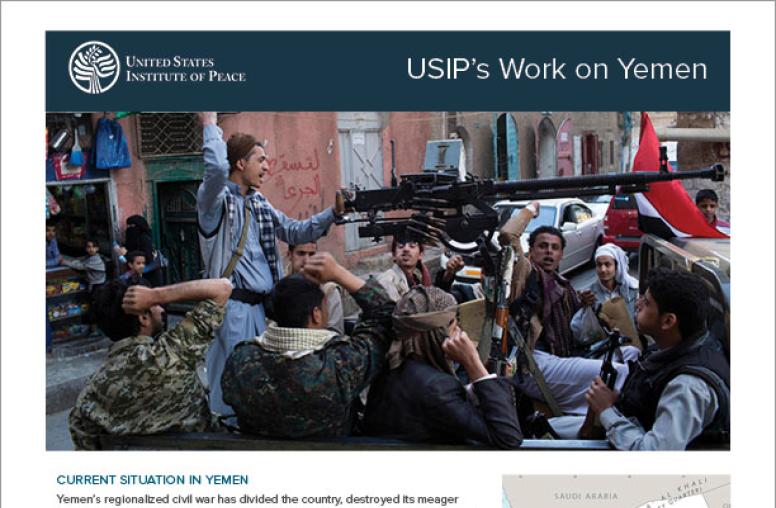Beneath the Saudi-Iran Proxy War in Yemen, Part 1
As U.S. Looks to Escalate, Local Realities Rule
Looking at the maneuvers by Iran and the Saudi-led coalition in Yemen from afar, the battlefield looks a lot like a black-and-white contest for regional power. But as the U.S. considers escalating its role in the conflict—and Secretary of Defense Jim Mattis visits Riyadh this week—it is essential to understand how local realities can get lost in a proxy war.

On the ground, Yemen is grappling with a multi-layered battlefield that has only widened—and even changed—the country’s pre-existing fractures in local politics, society and security. These tensions shape the course of Yemen’s civil war and any expanded U.S. involvement. If left unaddressed, they could spill across borders to further destabilize an already troubled region.
The violence has taken an enormous toll: In a country of 27.4 million, 50,000 people have been killed or injured, and more than 3 million have fled their homes. International organizations estimate that 19 million need humanitarian aid and 7 million face starvation. And now, Yemeni government forces and their Saudi coalition patrons are talking of an assault on the port of Hodeida to stop weapons and ammunition imports by their adversaries, an operation that the United Nations warns would imperil food supplies. The port accounts for about 80 percent of the country’s food imports.
Meanwhile, the country’s power vacuum has allowed the Islamic State (ISIS) and Al-Qaeda in the Arabian Peninsula (AQAP) to thrive. AQAP, the group linked to multiple attacks and attempts in the United States and Europe, has expanded its base inside Yemen. It is recruiting new fighters and providing public services to make itself more acceptable to the local population.
These tensions shape the course of Yemen’s civil war and any expanded U.S. involvement.
ISIS has formed a nascent yet deadly presence, staging attacks on military and police targets in the south. The Houthis, too, are pushing beyond their domestic base. After firing rockets at U.S. navy ships and causing casualties and damage with missile attacks on villages and cities in southern Saudi Arabia, the group is threatening the Bab al-Mandeb strait, an important international trade route.
The conflict in Yemen is generally portrayed as a fight between the Iranian-backed Houthis, a Yemeni Zaidi Shia sect that controls the capital in an alliance with former President Ali Abdullah Saleh, and the internationally recognized government aligned with the Sunni regimes of Saudi Arabia and the United Arab Emirates. The longstanding internal conflicts, in turn, have been altered by Saudi Arabia’s lethal air campaign against the Houthis, supported to varying degrees by the U.S., and the Houthis’ use of increasingly potent weapons that the U.S. says come from Iran.
Internal Ruptures
But even the areas under the control of each side continue to face internal ruptures. While the Houthi-Saleh alliance appeared to be more cohesive, disagreements exist, and they have their own history of internecine fighting. A power struggle between the “national salvation” government and the Supreme Political Council, which was created in August, emerged early on.
The separate government of President Abed Rabbo Mansour Hadi continues to struggle to gain control over the areas under its authority. Elements of the southern separatist movement, Hirak, have grown stronger and are quietly cementing their dominance over local political structures in the south.
And all these divisions have been compounded by the proliferation of armed groups that hold and control territory, and by the competition over money, arms and political support from foreign powers.
Mattis said this week that U.N.-brokered negotiations are needed to resolve the conflict. At the same time, he said he would discuss in Riyadh how to “deepen and broaden” U.S.-Saudi ties. The latest U.N.-sponsored peace talks collapsed in August 2016; even while they were underway, many Yemenis assumed they would fail either because the parties benefit from the status quo or because the negotiations wouldn’t address the sources of hostilities at the local level. The mere existence of two governments will create political and procedural hurdles to any resolution.
U.S. Institute of Peace partners in Yemen stress the need to develop a deeper understanding of the situation on the ground – particularly at the provincial and district levels. They urge local-level conflict mitigation in the absence of near-term prospects for a national peace agreement.
The Risks of Delay
Between 2013 and 2014, USIP worked with Yemeni civil society organizations to strengthen the country’s justice system and the rule of law. New projects are now under consideration for funding by USIP to enhance community-based dialogue and ease social tensions.
Yemen clearly requires a political solution at the top, as Mattis noted. Yet waiting for a national agreement with so many causes of conflict in play may mean losing a chance to prevent cycles of violence from taking root in local communities.
Yemeni individuals and organizations can provide connections and access that the international community does not have. But the risk of famine, the continued fighting, the displacement of families and the lack of funding for significant efforts will drain their capabilities. International assistance needs to extend beyond military efforts and humanitarian aid to bolstering the ability of Yemenis to address their own underlying conflicts.
Only a multi-layered strategy that corresponds to the complexity of the conflict stands a chance of offering Yemen’s people some relief and curbing the appeal and power of ever-more virulent and numerous extremist groups.
Read Part 2: As U.S. Looks to Escalate, Local Realities Rule



